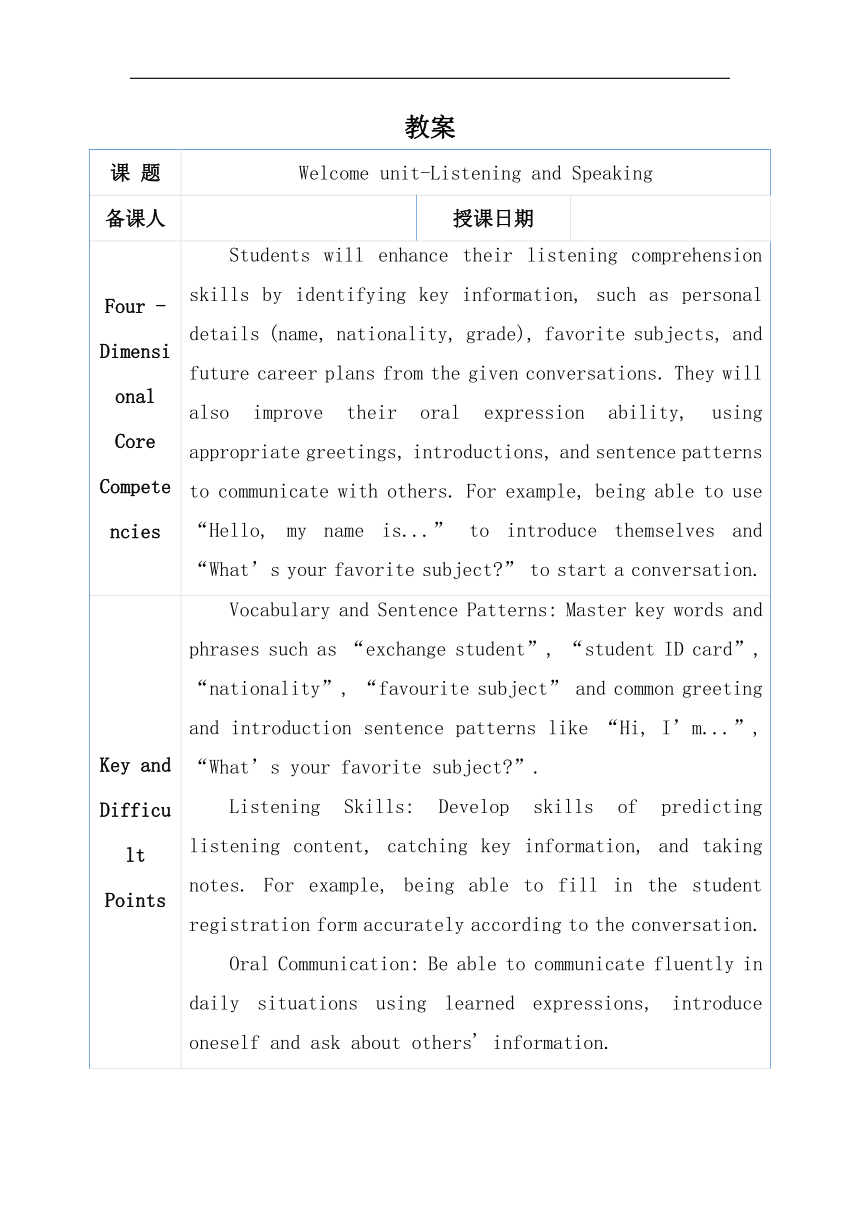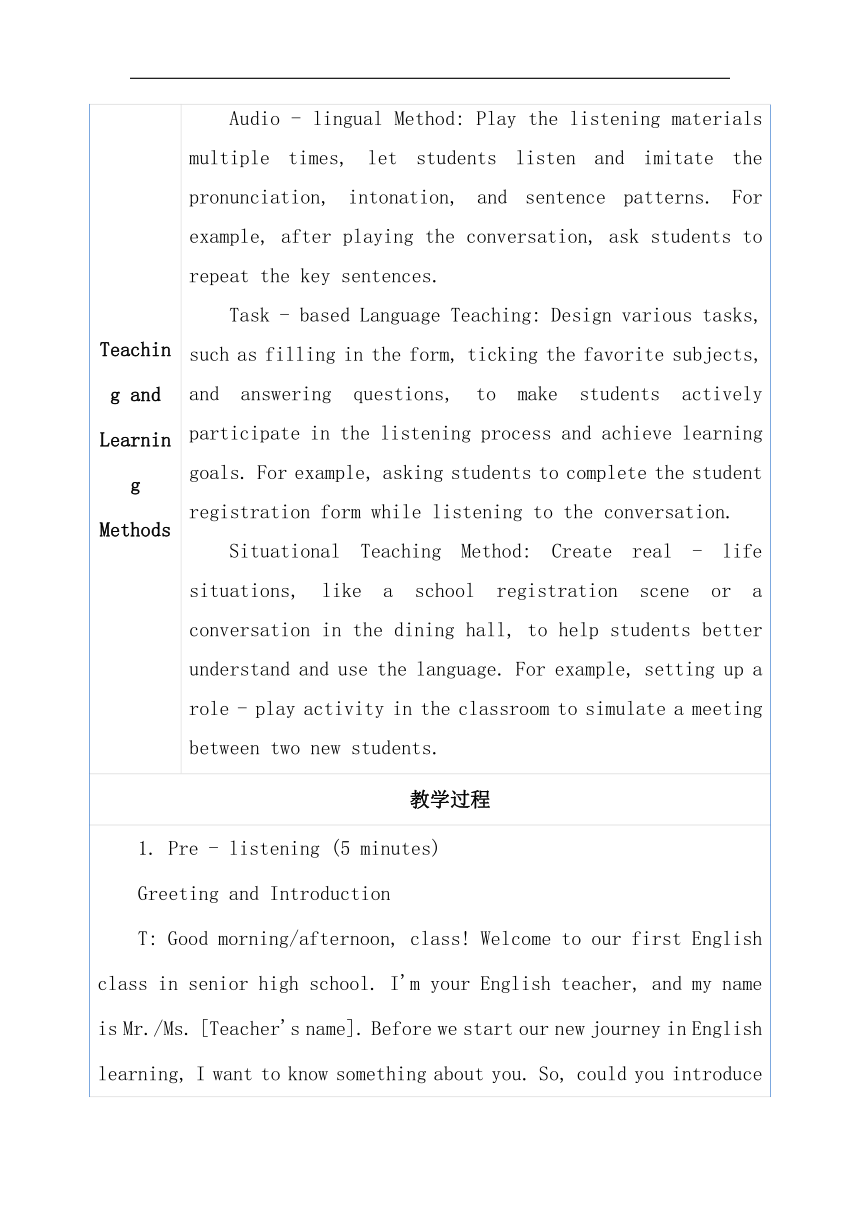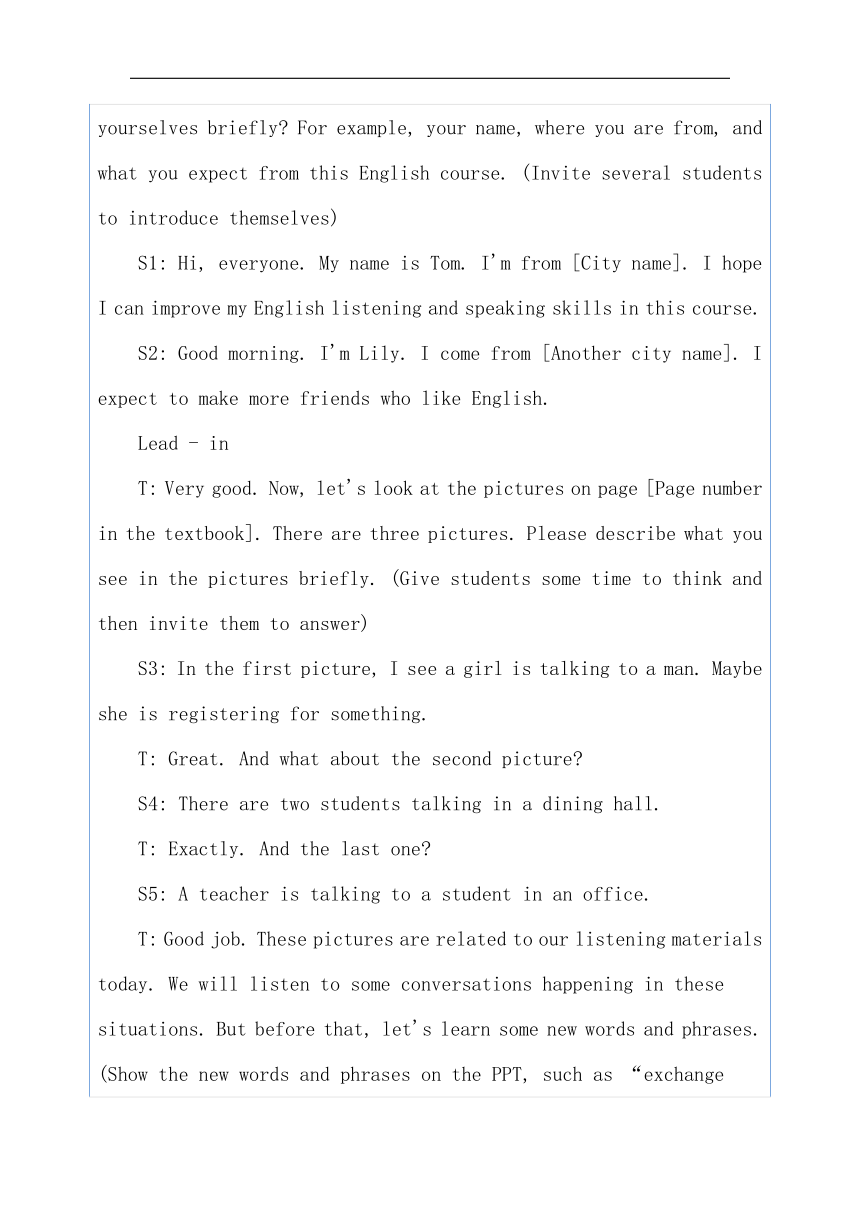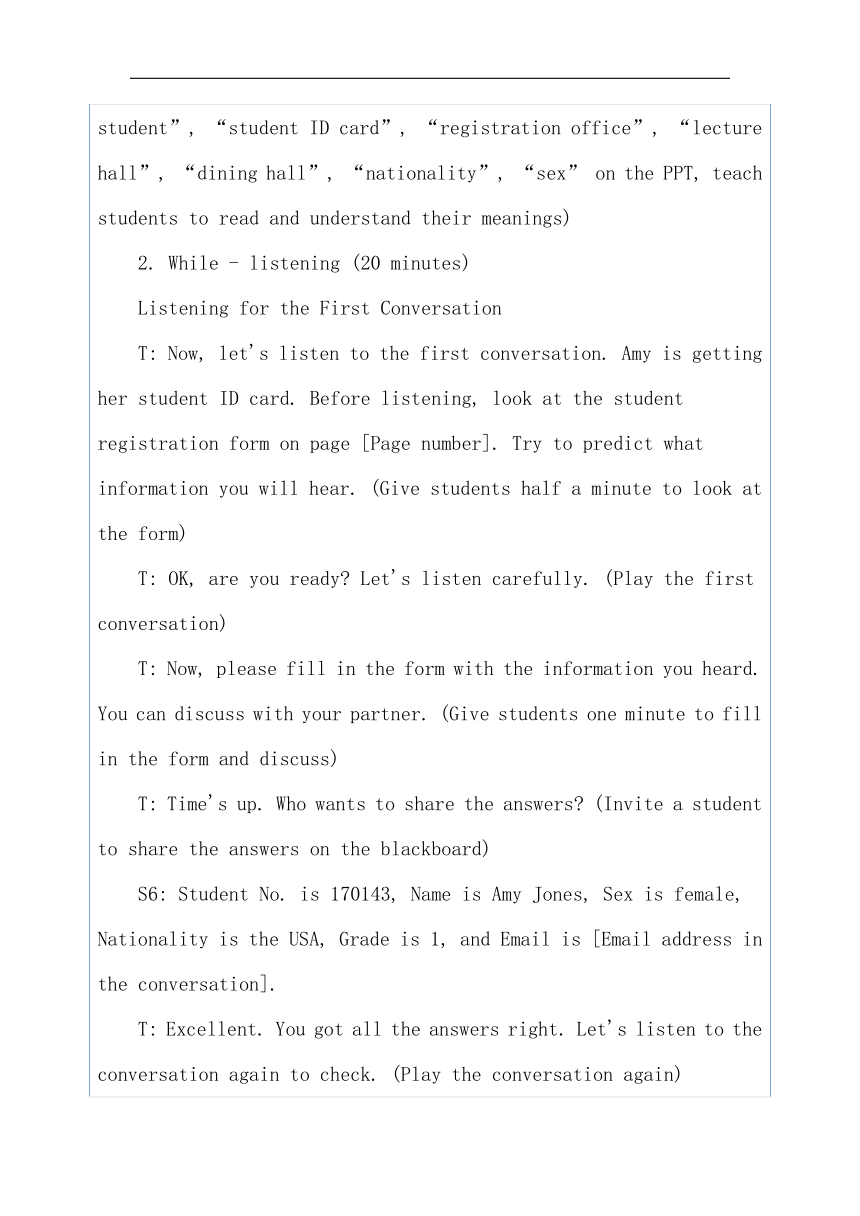Welcome unit-Listening and Speaking教案2025-2026学年人教版英语必修第一册
文档属性
| 名称 | Welcome unit-Listening and Speaking教案2025-2026学年人教版英语必修第一册 |

|
|
| 格式 | docx | ||
| 文件大小 | 22.2KB | ||
| 资源类型 | 教案 | ||
| 版本资源 | 人教版(2019) | ||
| 科目 | 英语 | ||
| 更新时间 | 2025-08-08 14:41:30 | ||
图片预览




文档简介
教案
课 题 Welcome unit-Listening and Speaking
备课人 授课日期
Four - Dimensional Core Competencies Students will enhance their listening comprehension skills by identifying key information, such as personal details (name, nationality, grade), favorite subjects, and future career plans from the given conversations. They will also improve their oral expression ability, using appropriate greetings, introductions, and sentence patterns to communicate with others. For example, being able to use “Hello, my name is...” to introduce themselves and “What’s your favorite subject ” to start a conversation.
Key and Difficult Points Vocabulary and Sentence Patterns: Master key words and phrases such as “exchange student”, “student ID card”, “nationality”, “favourite subject” and common greeting and introduction sentence patterns like “Hi, I’m...”, “What’s your favorite subject ”. Listening Skills: Develop skills of predicting listening content, catching key information, and taking notes. For example, being able to fill in the student registration form accurately according to the conversation. Oral Communication: Be able to communicate fluently in daily situations using learned expressions, introduce oneself and ask about others' information.
Teaching and Learning Methods Audio - lingual Method: Play the listening materials multiple times, let students listen and imitate the pronunciation, intonation, and sentence patterns. For example, after playing the conversation, ask students to repeat the key sentences. Task - based Language Teaching: Design various tasks, such as filling in the form, ticking the favorite subjects, and answering questions, to make students actively participate in the listening process and achieve learning goals. For example, asking students to complete the student registration form while listening to the conversation. Situational Teaching Method: Create real - life situations, like a school registration scene or a conversation in the dining hall, to help students better understand and use the language. For example, setting up a role - play activity in the classroom to simulate a meeting between two new students.
教学过程
1. Pre - listening (5 minutes) Greeting and Introduction T: Good morning/afternoon, class! Welcome to our first English class in senior high school. I'm your English teacher, and my name is Mr./Ms. [Teacher's name]. Before we start our new journey in English learning, I want to know something about you. So, could you introduce yourselves briefly For example, your name, where you are from, and what you expect from this English course. (Invite several students to introduce themselves) S1: Hi, everyone. My name is Tom. I'm from [City name]. I hope I can improve my English listening and speaking skills in this course. S2: Good morning. I'm Lily. I come from [Another city name]. I expect to make more friends who like English. Lead - in T: Very good. Now, let's look at the pictures on page [Page number in the textbook]. There are three pictures. Please describe what you see in the pictures briefly. (Give students some time to think and then invite them to answer) S3: In the first picture, I see a girl is talking to a man. Maybe she is registering for something. T: Great. And what about the second picture S4: There are two students talking in a dining hall. T: Exactly. And the last one S5: A teacher is talking to a student in an office. T: Good job. These pictures are related to our listening materials today. We will listen to some conversations happening in these situations. But before that, let's learn some new words and phrases. (Show the new words and phrases on the PPT, such as “exchange student”, “student ID card”, “registration office”, “lecture hall”, “dining hall”, “nationality”, “sex” on the PPT, teach students to read and understand their meanings) 2. While - listening (20 minutes) Listening for the First Conversation T: Now, let's listen to the first conversation. Amy is getting her student ID card. Before listening, look at the student registration form on page [Page number]. Try to predict what information you will hear. (Give students half a minute to look at the form) T: OK, are you ready Let's listen carefully. (Play the first conversation) T: Now, please fill in the form with the information you heard. You can discuss with your partner. (Give students one minute to fill in the form and discuss) T: Time's up. Who wants to share the answers (Invite a student to share the answers on the blackboard) S6: Student No. is 170143, Name is Amy Jones, Sex is female, Nationality is the USA, Grade is 1, and Email is [Email address in the conversation]. T: Excellent. You got all the answers right. Let's listen to the conversation again to check. (Play the conversation again) Listening for the Second Conversation T: Well done. Now, let's move on to the second conversation. Max meets Amy in the dining hall. Look at the task on page [Page number]. You need to tick Max's favourite subject and Amy's favourite subject. Read the subjects first and think about what you might hear. (Give students 30 seconds to read the subjects) T: Let's listen. (Play the second conversation) T: Stop. Please tick the boxes. (Give students half a minute to tick) T: Who can tell me the answers S7: Max's favourite subject is Maths, and Amy's favourite subject is Chemistry. T: Correct. Now, let's have a discussion. What other subjects do you take in senior high school Talk to your partner. (Give students two minutes to discuss, then invite some pairs to share their ideas) Pair 1: We take Chinese, English, Maths, Physics, Chemistry, Biology, Politics, History, and Geography. Listening for the Third Conversation T: Good. Now, we will listen to the third conversation. Amy is talking to Ms Li, a school adviser, about which courses to choose. Read the questions on page [Page number] before listening. Try to predict the answers. (Give students 30 seconds to read the questions) T: Listen carefully. (Play the third conversation) T: Now, answer the questions. You can discuss with your partner. (Give students one minute to discuss and answer) T: Who wants to answer the first question What does Amy want to be in the future S8: She wants to be a designer. T: Right. And the second question What course will Amy probably choose S9: She will probably choose an art course. T: Great. Let's listen to the conversation again to confirm. (Play the conversation again) 3. Post - listening (15 minutes) Role - play T: Now, it's your turn to practice speaking. We have three situations here. (Show the situations on the PPT: A boy meets a girl during a break. An exchange student is talking to a teacher on campus. A boy and a girl are at the airport to meet a visiting group of teachers and students from England.) Choose one situation and make a conversation with your partner. Try to use the introductions and greetings we learned today. You can start like this: “Hi, I'm...” or “Hello, nice to meet you.” (Give students five minutes to prepare the conversation) T: Time's up. Which pair wants to come to the front and show your conversation (Invite several pairs to perform) Pair 2 (performing the first situation): Boy: Hi, I'm Jack. Nice to meet you. Girl: Hi, Jack. I'm Lucy. Nice to meet you too. Boy: What do you think of our new school Girl: It's very big and beautiful. How about you Boy: I agree. By the way, what's your favorite subject Girl: I like English best. What about you Boy: I like Maths. T: Very good. Your conversation is natural and you used the expressions correctly. Let's give them a round of applause. Pronunciation Practice T: Next, let's focus on pronunciation. Listen and repeat. Notice the pronunciation of the vowels (A, E, I, O, U). (Play the audio of vowel pronunciation, and students follow to repeat) T: Now, I'll give you some words. You need to read them out and tell me which vowel sound they contain. (Show some words on the PPT, such as “name”, “bed”, “bike”, “go”, “use”, invite students to read and answer) S10: “name” contains the vowel sound /e /. T: Correct. Well done. 4. Summary and Homework (5 minutes) Summary T: Today, we have listened to three conversations and learned how to introduce ourselves, ask about others' information, and talk about favorite subjects and future plans. We also practiced our pronunciation. Remember to use these expressions in your daily life. Homework T: For homework, I want you to make a short video of your own conversation using the situations we practiced today. You can send it to our class group. And also, review the new words and sentence patterns we learned today.
课 题 Welcome unit-Listening and Speaking
备课人 授课日期
Four - Dimensional Core Competencies Students will enhance their listening comprehension skills by identifying key information, such as personal details (name, nationality, grade), favorite subjects, and future career plans from the given conversations. They will also improve their oral expression ability, using appropriate greetings, introductions, and sentence patterns to communicate with others. For example, being able to use “Hello, my name is...” to introduce themselves and “What’s your favorite subject ” to start a conversation.
Key and Difficult Points Vocabulary and Sentence Patterns: Master key words and phrases such as “exchange student”, “student ID card”, “nationality”, “favourite subject” and common greeting and introduction sentence patterns like “Hi, I’m...”, “What’s your favorite subject ”. Listening Skills: Develop skills of predicting listening content, catching key information, and taking notes. For example, being able to fill in the student registration form accurately according to the conversation. Oral Communication: Be able to communicate fluently in daily situations using learned expressions, introduce oneself and ask about others' information.
Teaching and Learning Methods Audio - lingual Method: Play the listening materials multiple times, let students listen and imitate the pronunciation, intonation, and sentence patterns. For example, after playing the conversation, ask students to repeat the key sentences. Task - based Language Teaching: Design various tasks, such as filling in the form, ticking the favorite subjects, and answering questions, to make students actively participate in the listening process and achieve learning goals. For example, asking students to complete the student registration form while listening to the conversation. Situational Teaching Method: Create real - life situations, like a school registration scene or a conversation in the dining hall, to help students better understand and use the language. For example, setting up a role - play activity in the classroom to simulate a meeting between two new students.
教学过程
1. Pre - listening (5 minutes) Greeting and Introduction T: Good morning/afternoon, class! Welcome to our first English class in senior high school. I'm your English teacher, and my name is Mr./Ms. [Teacher's name]. Before we start our new journey in English learning, I want to know something about you. So, could you introduce yourselves briefly For example, your name, where you are from, and what you expect from this English course. (Invite several students to introduce themselves) S1: Hi, everyone. My name is Tom. I'm from [City name]. I hope I can improve my English listening and speaking skills in this course. S2: Good morning. I'm Lily. I come from [Another city name]. I expect to make more friends who like English. Lead - in T: Very good. Now, let's look at the pictures on page [Page number in the textbook]. There are three pictures. Please describe what you see in the pictures briefly. (Give students some time to think and then invite them to answer) S3: In the first picture, I see a girl is talking to a man. Maybe she is registering for something. T: Great. And what about the second picture S4: There are two students talking in a dining hall. T: Exactly. And the last one S5: A teacher is talking to a student in an office. T: Good job. These pictures are related to our listening materials today. We will listen to some conversations happening in these situations. But before that, let's learn some new words and phrases. (Show the new words and phrases on the PPT, such as “exchange student”, “student ID card”, “registration office”, “lecture hall”, “dining hall”, “nationality”, “sex” on the PPT, teach students to read and understand their meanings) 2. While - listening (20 minutes) Listening for the First Conversation T: Now, let's listen to the first conversation. Amy is getting her student ID card. Before listening, look at the student registration form on page [Page number]. Try to predict what information you will hear. (Give students half a minute to look at the form) T: OK, are you ready Let's listen carefully. (Play the first conversation) T: Now, please fill in the form with the information you heard. You can discuss with your partner. (Give students one minute to fill in the form and discuss) T: Time's up. Who wants to share the answers (Invite a student to share the answers on the blackboard) S6: Student No. is 170143, Name is Amy Jones, Sex is female, Nationality is the USA, Grade is 1, and Email is [Email address in the conversation]. T: Excellent. You got all the answers right. Let's listen to the conversation again to check. (Play the conversation again) Listening for the Second Conversation T: Well done. Now, let's move on to the second conversation. Max meets Amy in the dining hall. Look at the task on page [Page number]. You need to tick Max's favourite subject and Amy's favourite subject. Read the subjects first and think about what you might hear. (Give students 30 seconds to read the subjects) T: Let's listen. (Play the second conversation) T: Stop. Please tick the boxes. (Give students half a minute to tick) T: Who can tell me the answers S7: Max's favourite subject is Maths, and Amy's favourite subject is Chemistry. T: Correct. Now, let's have a discussion. What other subjects do you take in senior high school Talk to your partner. (Give students two minutes to discuss, then invite some pairs to share their ideas) Pair 1: We take Chinese, English, Maths, Physics, Chemistry, Biology, Politics, History, and Geography. Listening for the Third Conversation T: Good. Now, we will listen to the third conversation. Amy is talking to Ms Li, a school adviser, about which courses to choose. Read the questions on page [Page number] before listening. Try to predict the answers. (Give students 30 seconds to read the questions) T: Listen carefully. (Play the third conversation) T: Now, answer the questions. You can discuss with your partner. (Give students one minute to discuss and answer) T: Who wants to answer the first question What does Amy want to be in the future S8: She wants to be a designer. T: Right. And the second question What course will Amy probably choose S9: She will probably choose an art course. T: Great. Let's listen to the conversation again to confirm. (Play the conversation again) 3. Post - listening (15 minutes) Role - play T: Now, it's your turn to practice speaking. We have three situations here. (Show the situations on the PPT: A boy meets a girl during a break. An exchange student is talking to a teacher on campus. A boy and a girl are at the airport to meet a visiting group of teachers and students from England.) Choose one situation and make a conversation with your partner. Try to use the introductions and greetings we learned today. You can start like this: “Hi, I'm...” or “Hello, nice to meet you.” (Give students five minutes to prepare the conversation) T: Time's up. Which pair wants to come to the front and show your conversation (Invite several pairs to perform) Pair 2 (performing the first situation): Boy: Hi, I'm Jack. Nice to meet you. Girl: Hi, Jack. I'm Lucy. Nice to meet you too. Boy: What do you think of our new school Girl: It's very big and beautiful. How about you Boy: I agree. By the way, what's your favorite subject Girl: I like English best. What about you Boy: I like Maths. T: Very good. Your conversation is natural and you used the expressions correctly. Let's give them a round of applause. Pronunciation Practice T: Next, let's focus on pronunciation. Listen and repeat. Notice the pronunciation of the vowels (A, E, I, O, U). (Play the audio of vowel pronunciation, and students follow to repeat) T: Now, I'll give you some words. You need to read them out and tell me which vowel sound they contain. (Show some words on the PPT, such as “name”, “bed”, “bike”, “go”, “use”, invite students to read and answer) S10: “name” contains the vowel sound /e /. T: Correct. Well done. 4. Summary and Homework (5 minutes) Summary T: Today, we have listened to three conversations and learned how to introduce ourselves, ask about others' information, and talk about favorite subjects and future plans. We also practiced our pronunciation. Remember to use these expressions in your daily life. Homework T: For homework, I want you to make a short video of your own conversation using the situations we practiced today. You can send it to our class group. And also, review the new words and sentence patterns we learned today.
